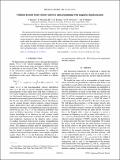Collision kernels from velocity-selective optical pumping with magnetic depolarization
Author(s)
Bhamre, T.; Kominis, I. K.; McGuyer, B. H.; Happer, W.; Marsland, Robert Alvin
DownloadBhamre-2013-Collision kernels from.pdf (293.6Kb)
PUBLISHER_POLICY
Publisher Policy
Article is made available in accordance with the publisher's policy and may be subject to US copyright law. Please refer to the publisher's site for terms of use.
Terms of use
Metadata
Show full item recordAbstract
We experimentally demonstrate how magnetic depolarization of velocity-selective optical pumping can be used to single out the collisional cusp kernel best describing spin- and velocity-relaxing collisions between potassium atoms and low-pressure helium. The range of pressures and transverse fields used simulate the optical pumping regime pertinent to sodium guidestars employed in adaptive optics. We measure the precession of spin-velocity modes under the application of transverse magnetic fields, simulating the natural configuration of mesospheric sodium optical pumping in the geomagnetic field. We also provide a full theoretical account of the experimental data using the recently developed cusp kernels, which realistically quantify velocity damping collisions in this optical pumping regime. A single cusp kernel with a sharpness s = 13 ± 2 provides a global fit to the K-He data.
Date issued
2013-04Department
Massachusetts Institute of Technology. Department of PhysicsJournal
Physical Review A
Publisher
American Physical Society
Citation
Bhamre, T., R. Marsland, I. Kominis, B. McGuyer, and W. Happer. "Collision kernels from velocity-selective optical pumping with magnetic depolarization." Phys. Rev. A 87, 043412 (April 2013). © 2013 American Physical Society
Version: Final published version
ISSN
1050-2947
1094-1622